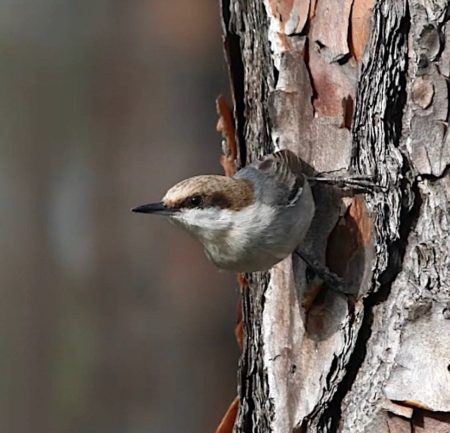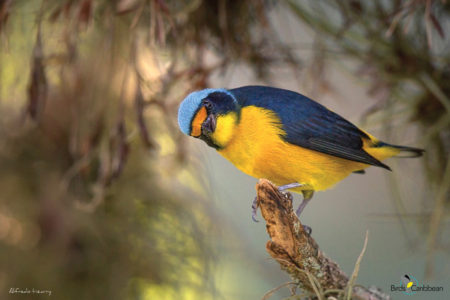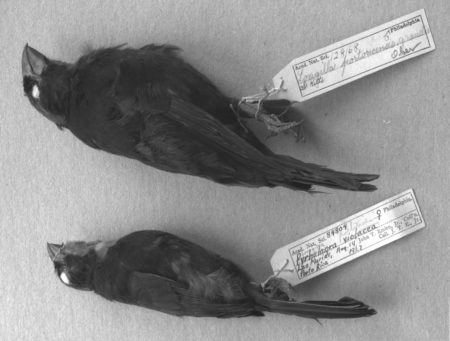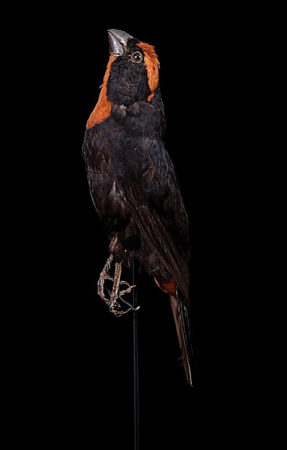The American Society of Ornithology (AOS) recently announced the newest taxonomic changes for North American birds in the Sixty-second Supplement to the American Ornithological Society’s Check-list of North American Birds. There is some exciting news, but it is bittersweet. Read on for more details.
Bahama Nuthatch declared a full species

The Bahama Nuthatch (Sitta insularis), formerly considered a subspecies of the Brown-headed Nuthatch (Sitta pusilla), has finally been split from the Brown-headed Nuthatch. This elevates the Bahama Nuthatch to a full species, meaning we now have a new Caribbean and Bahamas endemic!
The Bahama Nuthatch was split from the Brown-headed Nuthatch due to research showing differences in vocalizations. The calls of the Bahama Nuthatch are strikingly different from those of the Brown-headed Nuthatch, including a unique, rapid, high “warble.” In addition, there is a weak response of each species to playback of vocalizations of the other species. In other words, each species does not recognize the other as members of the same species. Additionally, there are some physical differences that distinguish the Bahama Nuthatch such as a much darker brown facial stripe, much longer bill, and considerably shorter wings.
Sadly, this species may now be extinct. Found on only ONE island in the Bahamas – Grand Bahama- it was exceedingly rare after Hurricane Matthew pummeled Grand Bahama in 2016 followed by Hurricane Irma in 2017. Only 5 birds were found after intensive surveys in 2018. It has not been seen since the Category 5 Hurricane Dorian caused catastrophic damage and massive flooding of its pine forest habitat in September 2019.
Bahamian Biologist, Scott Johnson commented, “After many years and a lot of research, the Bahama Nuthatch has been elevated to full species status (although many of us knew and recognized it as such for a while now). Sadly, we are not sure if it is still alive. Hurricane Dorian destroyed the only place on Grand Bahama where it was found. I will be keeping an eye and ear out for this species during my next trip to GB.”
More surveys are urgently needed. We hope we can still find this incredibly special bird and find a way to bring it back. In the meantime, conserving its pine forest habitat is paramount!
St. Kitts Bullfinch granted full species status
Since it was first described by George Lawrence in 1881, the St. Kitts Bullfinch was considered a sub-species of the Puerto Rican Bullfinch (Milopyrrha portorinsis). This bird, locally known as the St. Kitts Bullfinch (Melopyrrha portoricensis grandis), was living in St. Kitts with a restricted distribution on the upper slopes of Mt. Misery.
However, the AOS have formally amended the status of the St. Kitts bird from a subspecies to a distinct full species, now officially named the St. Kitts Bullfinch (Milopyrrha grandis). This gives St. Kitts its first and only endemic bird! The catch – this bird has been extinct for almost 100 years!
The last official sighting (a collected bird) was in 1929. . . but there’s hope. There have been two reported sightings without photographs in 1993 and 2012. And in 2021 a sonagram (bird song recording) experiment may have recorded the St. Kitt’s Bullfinch; results are still being analyzed. It is likely that the St. Kitts Bullfinch is an elusive species and difficult to see, like the Puerto Rican Bullfinch. So maybe it is still alive and hiding in the remote high forests of St. Kitts, holding on precariously to life, and waiting to be rediscovered!
Thanks to a few specimens and a PhD study on this unique bullfinch, the St. Kitt’s Bullfinch was differentiated from the Puerto Rican Bullfinch by a larger size of about 25%, bigger and heavier beak, and differences in coloration. The St. Kitts Bullfinch has consistent black markings on the undertail coverts that the Puerto Rico birds do not have. In addition, the plumage of St. Kitts birds is more glossy black and the throat and upper breast patch is more extended and darker reddish-brown.
What caused the extinction of this species? It’s hypothesized that the St. Kitt’s Bullfinch likely existed with a very restricted range on Mt. Liamuiga. It was thought to be common in the 1890s but when two large hurricanes struck in 1899, the bullfinch disappeared. You can read more about the St. Kitt’s Bullfinch here and here.
Other Caribbean taxonomic updates
Additionally, there were a few interesting broader reclassifications published in the AOS Supplement. The Antillean Piculet (Nesoctites micromegas) is reclassified as no longer belonging to the Piculet subfamily. Recent genetic evidence shows that these unique Caribbean picids are more closely related to woodpeckers (subfamily Picinae) than to the smaller South American piculets. However, the Antillean Piculet still lacks some classic woodpecker features such as stiffened rectrices (tail feathers) and adaptations for drilling, making it unique among both piculets and woodpeckers.

Another Caribbean classic, the Antillean Euphonia (Euphonia musica), has been reclassified with the genus name—Chlorophonia musica. Recent genetic analyses have distinguished Antillean Euphonia as well as its cousin, the Elegant Euphonia, as more closely related to the Chlorophonia finches than the Euphonias (all within Family Fringillidae).
Another generic change—Jamaican Owl has been moved from Pseudoscops grammicus to Asio grammicus.
Finally, Crested Caracara (Caracara cherway) and Southern Caracara (Caracara plancus) have been lumped into a single species Caracara plancus.
We are excited to welcome the two new species of endemics to the BirdsCaribbean family, and hope beyond hope that they somehow still survive. Caribbean birds remain understudied and we hope future research will help us solve some other taxonomic mysteries in the Caribbean.
Thanks to Michael Ryan and his blog article about the St. Kitts Bullfinch on the Birders of St. Kitts & Nevis website for further information and context.


